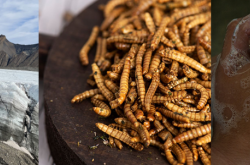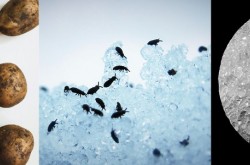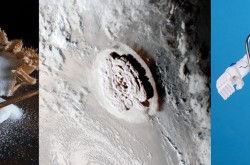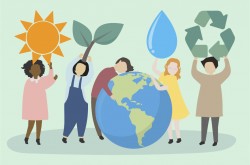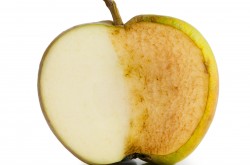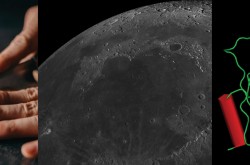3 things you should know about pig to human organ transplants, the shape of the Earth, and fertilizers

Meet Renée-Claude Goulet, Michelle Campbell Mekarski, and Cassandra Marion.
They are Ingenium’s science advisors, providing expert scientific advice on key subjects relating to the Canada Agriculture and Food Museum, the Canada Science and Technology Museum, and the Canada Aviation and Space Museum.
In this colourful monthly blog series, Ingenium’s science advisors offer up three quirky nuggets related to their areas of expertise. For the July edition, they tell us how a human received a kidney transplant from a pig, how we know the Earth is round, why fertilizing plants can be tricky!

Kidneys are the most frequently needed organs for transplants. At the end of 2022, about 73 percent (or more than 2,750 people) of those in Canada waiting for an organ transplant were waiting for a kidney. Specially engineered pig kidneys could be a solution.
Medical Milestone: A human has successfully received a pig’s kidney
Every year, the number of Canadians diagnosed with organ failure rises, but there are never enough donors to meet the demand for transplants. Thousands of people in Canada are waiting for organ transplants, and hundreds will die every year as they wait.
Four years ago, I wrote a 3 things you should know article about how xenotransplantation is one possible solution to the organ shortage crisis. Xenotransplantation is the donation of organs from a non-human donor (e.g., skin grafts from fish, or heart valves from pigs). However, biological differences between species including genetic viruses, organ structure, and immune systems mean that xenotransplants are often rejected by the body, leaving the patient in a worse position.
At that time, several labs around the world were using genetic engineering to try to modify pig organs to make them suitable for transplantation into a human. Pigs were a natural focus, given that pig organs are about the same size as ours, and their immune systems are similar.
The future we talked about four years ago is here. The first genetically edited pig kidney has been successfully transplanted into a human. This milestone procedure was performed on March 16, 2024, by physicians at Harvard Medical School. The patient, Richard (Rick) Slayman, suffered from chronic kidney disease caused by type 2 diabetes and high blood pressure. He had already had a human kidney transplant, but that kidney started to fail after five years. Due to the advanced stage of his disease, he and his team of doctors were given permission to try – for the first time ever – transplanting a genetically modified pig kidney into a human.
The kidney Rick received was the result of decades of research by thousands of scientists and doctors. Using CRISPR-Cas9 gene-editing technology, scientists were able to make the pig kidney more compatible with humans by removing genes that would trigger immune rejection and adding genes to enhance compatibility. They also had to inactivate all viruses present in the pig DNA to eliminate any risk of infection. In total, they made 69 gene modifications.
The surgery was a success and Rick was able to leave the hospital two weeks later. Although he died two months later due to his underlying illness, his body did not reject the pig kidney.
Even though there are still many unknowns about this transplant approach, this procedure marks a major milestone in the quest to provide a second chance at life to the millions of patients dying from organ failure. Given another four years, maybe we will be living in a future where waiting for organ transplants is a not-so-distant memory.
By Michelle Campbell Mekarski

Partial view of a round Earth from the MESSENGER spacecraft, centred on Central America.
How do we know the Earth is round?
The curvature of our roughly spherical home planet can be observed in a variety of ways today, but it was not always the case.
The concept of a round Earth dates back to the time of the ancient Greeks. Around 500 B.C., the famous Pythagoras first proposed that the Earth was spherical, though he presented no direct evidence. He thought it to be the logical form because he believed a sphere is a perfect and stable shape. Aristotle, sometime around 350 B.C., was the first to present observable arguments which are still valid today. Firstly, ships disappear hull-first when sailing away over the horizon; the night sky’s constellations are different at different latitudes; and, finally, the Earth’s shadow cast on the Moon during a lunar eclipse shows the curvature of our fine planet.
Then came the astronomer and well-rounded scholar Eratosthenes in 240 B.C. who was the first to calculate the circumference of the Earth using measurements of shadow lengths cast by vertical sticks at a known distance apart. He had heard that in Syene (now Aswan, Egypt), the bottom of a well lit up entirely at noon on the summer solstice, without casting any shadows, meaning the Sun must be perfectly overhead at that time. Eratosthenes then measured the angle of a shadow cast by a stick at noon in Alexandria, Egypt, and found it made an angle of 7.2 degrees, equivalent to 1/50 of a complete circle (360 degrees). To ascertain the distance between Syene and Alexandria, he hired professional surveyors trained to walk with equal length steps. Their steps added up to 5,000 stadia, an ancient Greek unit of length, which equals about 800 km in today’s metric system. Using the observed shadow angles and the Syene-to-Alexandria distance, his estimate came very close to what we now know to be the Earth’s circumference: approximately 40,000 km (800 km multiplied by 50).
The distance to the visible horizon varies, depending on local topography and what may be in your line of sight like trees and even weather. It is generally easier to see the curvature of the Earth the higher your vantage point. Direct evidence of Earth’s curvature didn’t emerge until early in the twentieth century when advances in aviation enabled photographers to take flight. This is documented in a 1931 issue of the National Geographic Magazine, wherein a photo taken 7,000 m up in Argentina showed the Andes mountains were visible below the expected horizon. Similarly, in 1935, high altitude balloons in South Dakota ventured even higher and confirmed the Earth’s curvature. Then came sounding rockets, and the age of space exploration. Spacecraft have now imaged the Earth in its entirety, such as the first blue marble Earth in a single image from the Apollo era. As thousands of satellites orbit the Earth everyday, there is no doubt that it’s round.
Ways to test Earth's curvature yourself:
- Sunrise and Sunset: Note the varying times of sunrise and sunset at different locations that can only be explained by a curved Earth.
- Lunar Eclipse: Observe the Earth's curved shadow on the full Moon during a lunar eclipse.
- Shadow Measurements: Measure shadows cast by two sunlit vertical sticks at different latitudes and note the difference. Moreover, you can calculate Earth's circumference using the measured distance between them and the shadow angle.
- Horizon Observation: On a clear day along coastlines, observe the horizon's drop at the extremities due to Earth's curvature. Use a taut string between two sticks to see the horizon dip at the far right and the far left ends of the string. Watch large boats disappear bottom-first on the horizon.
- Aerial View: From a plane window on a clear day, observe the curved horizon. It will be subtle, but the higher your vantage point, the more visible the curvature becomes.
- Space Imagery: Although challenging to do yourself, reliable online sources and photos, like those from the Messenger mission above, clearly show Earth’s undeniable curvature from space.
For clarity, the Earth is in fact not a perfect sphere but an imperfect ellipsoid because it is flattened at the poles and wider at the equator. Perhaps a good topic for a future 3 Things edition is: Why does the Earth have this warped shape and how do we convert it to two dimensional maps?
By Cassandra Marion

Soil tests help farmers and gardeners troubleshoot problems with their plants and to know whether they need to add fertilizer to the soil.
Plants looking sad? They may just be hungry!
Good nutrition is key to healthy plants. But since it's so different from ours, and starts in the soil, it can be a difficult concept to understand and master. So, let's demystify some of the science behind feeding our plants!
Just like us, plants are little chemical factories, constantly transforming nutrients into other forms to grow tissues and enable internal processes that keep them and us alive and reproducing. While our human body chemical factories can convert a whole bunch of different substances (think proteins, carbs, fats, and vitamins) into other molecules, plants are a little different. Feeding a burger to a plant won’t do much to help it grow because the nutrients are too complex for a plant to use (until the burger is decomposed into its individual components, that is). Food for plants needs to be a lot simpler than ours, which is why we give them fertilizers.
Aside from oxygen, carbon, and hydrogen, agronomists consider that plants need six nutrients in greater amounts, and then another nine in lesser amounts, to reach their maximum potential. You probably know the main three; nitrogen (N), phosphorous (P), potassium (K). These are indicated by the three numbers separated by dashes on fertilizer packaging (N-P-K). Those numbers represent the quantity of each nutrient found in the product, as a percentage. This gives you an idea of how "strong" the product is.
In the "guaranteed minimum analysis" section of the packaging you might find the next three most important nutrients; sulfur (S), calcium (Ca) and magnesium (Mg). A complete fertilizer could also contain some of the nine micronutrients; boron (B), chloride (Cl), copper (Cu), iron (Fe), manganese (Mn), molybdenum (Mo), zinc (Zn), cobalt (Co) and Nickel (Ni).
Not all fertilizers contain all 15 nutrients! If only nitrogen is missing from your soil, you may use a fertilizer containing just nitrogen. If you're looking to fertilize once for the season and replenish all nutrients in one go, a slow release, complete fertilizer would be best.
When plants don’t get these nutrients, they start to show symptoms, such as yellowing leaves and stunted growth. Learning to recognize the symptoms can help us become better gardeners. The tricky part is that sometimes the nutrients are actually in the soil, but the plant just can’t absorb them. The presence or absence of beneficial soil microbes, too much or too little water, the wrong pH, which is a measure soil acidity, and even soil type – for example, clayey or sandy soil – can all throw some wrenches into the works. Soil tests can help you determine whether plants are suffering because nutrients are missing from the soil, or if there is another factor at play preventing the plants from absorbing them.
To help us understand what happens to fertilizers in the soil and why we want to be careful with them, we can think of soil and nutrients like magnets. Soil is typically slightly negatively charged, and nutrients in the soil each have either a positive or negative charge. Since opposites attract, positively charged nutrient can get “stuck” in the negative soil, while negatively charged nutrients, such as nitrate (N) and phosphate (P), stay loose.
Unused "loose" nutrients tend to leach out when it rains a lot or when the soil is overwatered, meaning we may be losing some fertilizers into the water table. This pollutes our drinking water and waterways. On the flipside, "sticky" nutrients can accumulate and become toxic to plants. This is why it's important for farmers and gardeners to evaluate whether plants need fertilizing and which kind, instead of applying willy-nilly.
Practical advice is to be a bit like a scientist! Keep an eye on your growing plants; learn the difference between symptoms of plant disease and nutrient deficiencies; do some soil nutrient tests; and, find out what type of soil you have and its pH. If you must apply fertilizers, carefully follow the directions on the packaging to prevent losing nutrients to the environment and to avoid over-fertilizing. And remember, too much water can be just as bad as too little!
By Renée-Claude Goulet
Enjoying the Ingenium Channel? Help us improve your experience with a short survey!

















